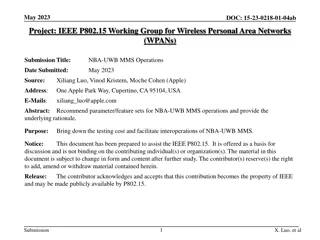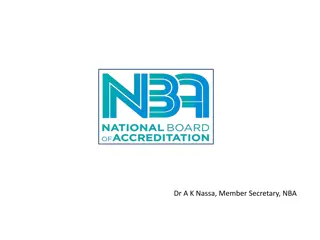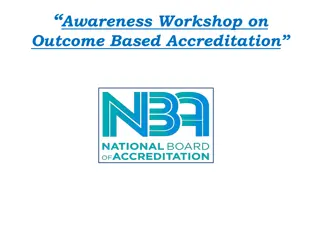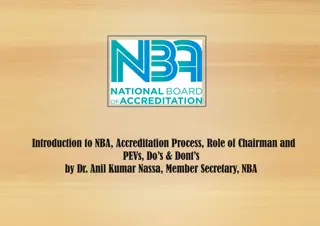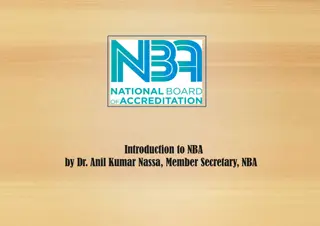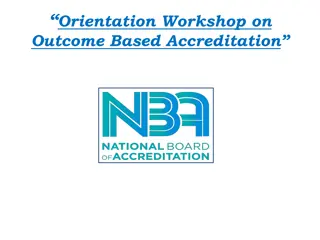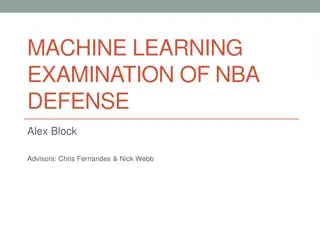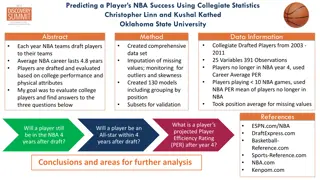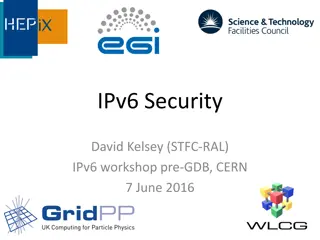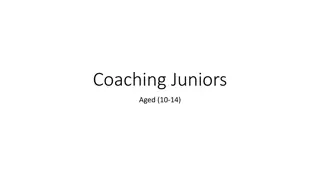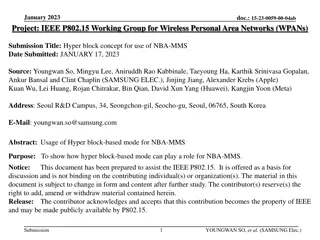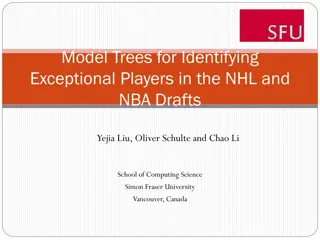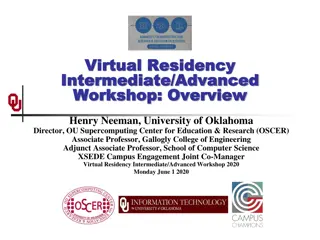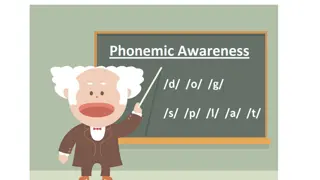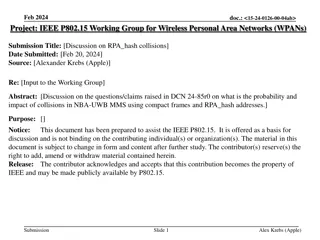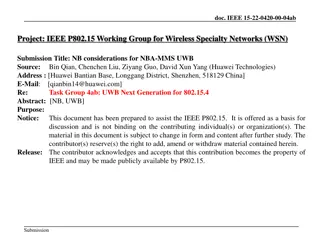
Engineering Activity Essentials
Explore the importance of engineering in meeting societal needs, economic development, and sustainable practices. Engineers play a crucial role in achieving UN Sustainable Development Goals by applying knowledge, skills, and ethical considerations. Discover the key aspects of engineering activities and the expected outcomes in terms of problem-solving, design, and development. Gain insights into the knowledge and attitude profile required for successful engineering practices.
Download Presentation

Please find below an Image/Link to download the presentation.
The content on the website is provided AS IS for your information and personal use only. It may not be sold, licensed, or shared on other websites without obtaining consent from the author. If you encounter any issues during the download, it is possible that the publisher has removed the file from their server.
You are allowed to download the files provided on this website for personal or commercial use, subject to the condition that they are used lawfully. All files are the property of their respective owners.
The content on the website is provided AS IS for your information and personal use only. It may not be sold, licensed, or shared on other websites without obtaining consent from the author.
E N D
Presentation Transcript
NBA Awareness NBA Awareness Workshop Workshop 1
What is Expected from Engineering Activity Engineering is an activity that is essential to meeting the needs of people, economic development and the provision of services to society Engineering involves the purposeful application of mathematical and natural sciences and a body of engineering knowledge, technology and techniques. Engineering must be carried out responsibly and ethically, use available resources efficiently, be economic, safeguard health and safety, be environmentally sound and sustainable and generally manage risks throughout the entire lifecycle of a system The United Nations Sustainable Development Goals present targets for 2030. Engineers are vital contributors for making progress towards these goals (17 SDGs)
WKs: Knowledge and Attitude Profile Applying Engineering Knowledge: WK1 Cognitive: Bloom s Taxonomy B L O O M S KNOWLEDGE P r o b l e m S o l v i n g Tool Usage Individual and Collaborative Work Communication Project Management and Finance WK2, WK6 Problem Analysis S K I L L Design and Development Programme Outcomes POs Investigation H I G H E R level WK2, WK3, WK4,WK8 11 POs in New SAR Psychomotor: Dave s Taxonomy LIFE ACTIVITIES Affective: Bloom s Taxonomy Attitude, Engineer and the World, Ethics, Values, Culture and Life-long learning WK5,WK7, WK9,
POs and WKs WK1: A systematic, theory-based understanding of the natural sciences applicable to the discipline and awareness of relevant social sciences. WK2: mathematics, numerical analysis, data analysis, statistics and formal aspects of computer and information science to support detailed analysis and modelling applicable to the discipline. WK3: A systematic, theory-based formulation of engineering fundamentals required in the engineering discipline. specialist knowledge that provides theoretical frameworks and bodies of knowledge for the accepted practice areas in the engineering discipline; much is at the forefront of the discipline. PO1: Engineering Knowledge: Apply knowledge mathematics, natural science, computing, fundamentals engineering specialization as specified in WK1 to WK4 respectively to develop to the solution of complex engineering problems. PO2: Problem Analysis: Identify, formulate, review literature and analyze complex engineering problems reaching substantiated conclusions with consideration for sustainable development. (WK1 to WK4) of engineering and Conceptually-based an WK4: Engineering research 4
POs and WKs PO3: Design/Development of Solutions: Design creative solutions for complex engineering problems design/develop systems/components/processes meet identified consideration for the public health and safety, whole-life cost, net zero carbon, culture, society and environment as required. (WK5) PO4: Conduct Investigations of Complex Problems: Conduct investigations of complex engineering problems using research-based knowledge including design of experiments, modelling, analysis & interpretation of data to provide valid conclusions. (WK8). WK5: Knowledge, including efficient resource use, impacts, whole-life cost, reuse of resources, net zero carbon, and similar concepts, that supports engineering design and operations in a practice area environmental and to needs with WK8: Engagement with selected knowledge in the current research literature of awareness of the power of critical thinking and creative approaches to evaluate emerging issues the discipline, 5
WK1: A systematic, theory-based understanding of the natural sciences applicable to the discipline and awareness of relevant social sciences. WK2: Conceptually-based mathematics, numerical analysis, data analysis, statistics and formal aspects of computer and information science to support detailed analysis and modelling applicable to the discipline. WK3: A systematic, theory-based formulation fundamentals required in the engineering discipline. WK4: Engineering specialist knowledge that provides theoretical frameworks and bodies of knowledge for the accepted practice areas in the engineering discipline; much is at the forefront of the discipline. WK5: Knowledge, including efficient resource use, environmental impacts, whole-life cost, reuse of resources, net zero carbon, and similar concepts, that supports engineering design and operations in a practice area. WK6: Knowledge of engineering practice (technology) in the practice areas in the engineering discipline. WK7: Knowledge of the role of engineering in society and identified issues in engineering practice in the discipline, such as the professional responsibility of an engineer to public safety and sustainable development. PO5: Usage: Create, select and apply techniques, resources and modern engineering & IT tools, including prediction and modelling recognizing their limitations to solve complex problems. (WK2 and WK6) PO6: The Engineer and The World: Analyze evaluate societal environmental while solving engineering problems for its impact on sustainability with reference to economy, health, safety, framework, culture and environment. (WK1, WK5, and WK7). Engineering Tool appropriate of engineering engineering and and aspects complex legal 6
POs and WKs WK8: selected knowledge in the current research literature of the discipline, awareness of the power of critical thinking and approaches emerging issues. Ethics, inclusive behavior and conduct. Knowledge of professional responsibilities, and norms of engineering Awareness of the need for diversity by ethnicity, gender, physical ability etc. with mutual understanding and respect, and of inclusive attitudes. Engagement with PO7: Ethics: Apply ethical principles and commit to professional ethics, human values, diversity and inclusion; adhere to national & international laws. (WK9) PO8: Individual and Collaborative Team work: Function effectively as an individual, and as a member or leader in diverse/multi-disciplinary teams. PO9: Communication: Communicate effectively and inclusively within the engineering PO10: Project Management and Finance: Apply knowledge and understanding of engineering management principles and economic decision-making and apply these to one s own work, as a member and leader in a team, and to manage projects and in multidisciplinary environments. PO11: Life-Long Learning: Recognize the need for, and have the preparation and ability for i) independent and life-long learning ii) adaptability to new and emerging technologies and iii) critical thinking in the broadest context of technological change. (WK8) creative evaluate WK9: to ethics, practice. reason of age, 7
PO PO1 1: : Engineering Engineering Knowledge natural science, computing, engineering fundamentals and an engineering specialization as specified in WK develop to the solution of complex Knowledge: : Apply Apply knowledge knowledge of mathematics, WK1 1 to to WK engineering problems WK4 4 respectively to complex engineering problems. . Breadth, Breadth, depth depth and and type type of of knowledge, knowledge, both both theoretical theoretical and and practical practical WK1: A systematic, theory-based understanding of the natural sciences applicable to the discipline and awareness of relevant social sciences. WK2: Conceptually-based mathematics, numerical analysis, data analysis, statistics and formal aspects of computer and information science to support detailed analysis and modelling applicable to the discipline. WK3: A systematic, theory-based formulation of engineering fundamentals required in the engineering discipline. WK4: Engineering specialist knowledge that provides theoretical frameworks and bodies of knowledge for the accepted practice areas in the engineering discipline; much is at the forefront of the discipline.
PO PO2 2: : Problem Problem Analysis complex complex engineering engineering problems consideration Analysis: : Identify, Identify, formulate, formulate, review problems reaching substantiated conclusions with sustainable development. review research literature and analyze analyze for (WK1 to WK4) Complexity Complexity of of analysis analysis WK1: A systematic, theory-based understanding of the natural sciences applicable to the discipline and awareness of relevant social sciences. WK2: Conceptually-based mathematics, numerical analysis, data analysis, statistics and formal aspects of computer and information science to support detailed analysis and modelling applicable to the discipline. WK3: A systematic, theory-based formulation of engineering fundamentals required in the engineering discipline. WK4: Engineering specialist knowledge that provides theoretical frameworks and bodies of knowledge for the accepted practice areas in the engineering discipline; much is at the forefront of the discipline.
PO PO3 3: : Design/Development Design/Development of of Solutions engineering engineering problems problems and design/develop meet identified needs with consideration for the public health and safety, whole-life cost, net zero carbon, culture, society and environment as required. (WK5) Breadth Breadth and and uniqueness uniqueness of of engineering engineering problems problems problems are are original original and and to to which which solutions solutions have or or codified codified Solutions: : Design design/develop systems/components/processes systems/components/processes to Design creative creative solutions solutions for for complex complex problems i i. .e e. . the have not not previously the extent extent to to which previously been been identified which identified WK5: Knowledge, including efficient resource use, environmental impacts, whole-life cost, re- use of resources, net zero carbon, and similar concepts, that supports engineering design and operations in a practice area.
PO PO4 4: : Conduct Conduct Investigations complex complex engineering engineering problems of experiments, modelling conclusions. Investigations of of Complex problems using research-based knowledge including design modelling, analysis analysis & & interpretation interpretation of data to provide valid Complex Problems Problems: : Conduct Conduct investigations investigations of of design (WK8). Breadth Breadth and and depth depth of of investigation investigation and and experimentation experimentation WK8: Engagement with selected knowledge in the current research literature of the discipline, awareness of the power of critical thinking and creative approaches to evaluate emerging issues
Programme Programme Outcomes Outcomes What are the knowledge+Skill+Life Activities and Attitude a graduate is going to inculcate during undergoing the programme and going to practice in the professional career Generic in nature Every component is measurable or quantifiable hence, outcomes In simple language these are the GUNNAs, a graduate is supposed to develop while going through the programme
POs (Outcome) PSOs (Outcome) PEOs (Objective) As per New SAR: 11 Defined by NBA The Graduates to attain during duration of 4 years Attributes or Gunn a students to imbibe/inculcate during the programme Defined for Programme i.e. UG/PG/MBA/MCA etc., Assessed using curriculum, teaching-learning, assessment and evaluation records etc. (09 criteria) 2 to 3 to be defined for each programme Fill up the gaps to contribute towards POs Attainment before getting the Degree Support specialization or beyond syllabus Defined for a particular programme of a discipline such as UG: Civil or PG: Electrical etc., Assessed using teaching- learning ,assessment records etc. 4 to 5 to be listed for each programme Expected to achieve after 3 to 4 years or beyond after degree It is like the dream the stakeholders see while establishing the institute/ Launching a programme POs and PSOs are feeder to PEOs Assessed using Alumni data and interacting with employers
PEOs PEOs PEO1: Globally acclaimed Telecommunication entrepreneur for space industries PEO2: Renowned Educationist with extraordinary professional accomplishments PEO3: Accomplished Scientist and Keen Investigator of Indian Knowledge System PEO4: Technical leaders to spearhead the advancement of telecommunications in the country Key Interrelationship Mapping Matrix with Mission: PEOs and Mission Articulation Matrix
OLD Evaluation Criteria NEW Criterion No. Criterion Titles Marks Criteria Criteria Marks No. 1 Outcome based Curriculum 120 Program Level Criteria Vision, Mission and Program Educational 1. 50 Objectives 2 Outcome based Teaching-Learning 120 Program Curriculum and Teaching 2. 100 Learning Processes 3 Outcome based Assessment 120 3. Course Outcomes and Program Outcomes 175 4. Students Performance 100 4 Students Performance 120 5. Faculty Information and Contributions 200 5 Faculty Information 100 6. Facilities and Technical Support 80 75 6 Faculty Contributions 120 7. Continuous Improvement Institute Level Criteria 7 Facilities and Technical Support 100 8. First Year Academics 50 8 Continuous Improvement 80 9. Student Support Systems 50 Governance, Institutional Support and 10. 120 Financial Resources 9 Students support and Governance 120 Total 1000 15
What and How of OBE OBE is a measurable quality improvement framework/system What do we want our students to achieve or imbibe? What do we want our students to achieve or imbibe? Captured in PROGRAM OUTCOMES [POs]. Achievement is judged by Captured in PROGRAM OUTCOMES [POs]. Achievement is judged by assessment and evaluation of attainment of assessment and evaluation of attainment of 11POs: How do our students achieve it? How do our students achieve it? Launched Launched outcome based curriculum outcome based curriculum imparted through effectiveness is measured by effectiveness is measured by assessment and evaluation assessment and evaluation. . Qualitative and quatitative rating is done by asseessment and evaluation Qualitative and quatitative rating is done by asseessment and evaluation of of Course Outcomes [COs] Course Outcomes [COs] What action is taken to address specialisation of a Programme? What action is taken to address specialisation of a Programme? Defining Programme Specific Outcomes Defining Programme Specific Outcomes (PSOs) How do we close the loop for further improvement How do we close the loop for further improvement (Continuous Quality Improvement (CQI) (CQI)? ? Make use of the assessment of attainment of Make use of the assessment of attainment of COs and POs and taking action low performing parameters/ criteria low performing parameters/ criteria 11POs: imparted through Teaching Teaching- -Learning Learning and and (PSOs) (Continuous Quality Improvement COs and POs and taking action on the on the
Outcome Based Curriculum Criterion 1 Maximum Score 120
Outcome Based Curriculum Outcome Based Curriculum Multidisciplinary Interdisciplinary Scope for critical thinking Complex problem solving Ethics and values are integral part Avenues for emerging technology, tools and experiencing in real environment Skills and hands-on are distributed and integrated in curriculum spreading over the years Teaches responsibilities Contributes to sustainable development Engaging and challenging leading to Holistic Development Flexible, Student s interest driven, diverse and options for student to explore the choices to best of the potential
Taxonomy Taxonomy Dave s Psychomotor Domain Respond Ability to participate responsibly, respectfully and actively Value Ability to associate personal and collective values and express value judgement Organise Ability to structure, priotize and reconcile personal and others value systems Receive Ability to lean from others Internalise Ability to articulate one s values and belief system
Outcome Based Assessment Criterion 3 Maximum Score 120
Assessment Tools Viva, Quiz, Seminar Mid-Sem and End-Sem Exam Home Assignment Project Work Tutorials Laboratory Test DIRECT INDIRECT Professional Society membership and position Result of Employer s Feedback GATE/CAT/GRE/Any national level test Alumni Feedback Exit survey Publications/ Patent/ Awards/ Rubrics
Bloom Verbs Bloom Verbs 30
Level Skill Demonstrated Question cues / Verbs for tests describe, explain, paraphrase, restate, 2. Understand understanding information grasp meaning associate, contrast, summarize, differentiate translate knowledge into new context interpret, discuss interpret facts, compare, contrast order, group, infer causes predict consequences 3. Apply use information calculate, predict, apply, solve, illustrate, use, use methods, concepts, laws, theories in new demonstrate, determine, model, experiment, situations show, examine, modify solve problems using required skills or knowledge Demonstrating correct usage of a method or procedure 4. Analyse break down a complex problem into parts classify, outline, break down, categorize, Identify the relationships and interaction between the analyze, diagram, illustrate, infer, select different parts of a complex problem identify the missing information, sometimes the redundant information and the contradictory information, if any Examination Reform Policy 44
Level Skill Demonstrated Question cues / Verbs for tests assess, decide, choose, rank, grade, 5. Evaluate compare and discriminate between ideas assess value of theories, presentations test, measure, defend, recommend, make choices based on reasoned argument convince, select, judge, support, verify value of evidence conclude, argue, justify, compare, recognize subjectivity summarize, evaluate use of definite criteria for judgments use old ideas to create new ones 6. Create design, formulate, build, invent, create, Combine parts to make (new) whole, compose, generate, derive, modify, generalize from given facts develop, integrate relate knowledge from several areas predict, draw conclusions It may be noted that some of the verbs in the above table are associated with multiple Bloom s Taxonomy levels. These verbs are actions that could apply to different activities. We need to keep in mind that it s the skill, action or activity we need students to demonstrate that will determine the contextual meaning of the verb used in the assessment question. Examination Reform Policy 45
Rubrics Elements of Rubrics Criteria for assessing Quality Levels Scoring strategy To grade assessment having more than one correct answer in efficient and equitable way Transparency in grading, as well as increase consistency in scoring Understand the purpose of an assignment Provide peer feedback, or to engage in self- assessment
Example: Analytic Rubrics Example: Analytic Rubrics Developing (2) Criteria\Quality Level Needs Improvement (1) Sufficient (3) Above Average (4) Clarity ( Supported by relevant information and ideas) Purpose is not well defined Central ideas are not focused Disconnected Relevancy of Information is weak Purpose is identified Ideas are generally focused to support the ideas Information supports ideas to some extent Purpose is clear Ideas are focused to support the thesis Relevant information provided to illustrate author s ideas Purpose is clear Ideas are always well focused Details are informative and relevant also enrich the work Organisation ( Sequencing of elements/ ideas) Ideas and information are poorly sequenced Presented in an oder Presented in an order and maintain a logical sequence Presented in order with logical sequence and connecting very well
Developmental Rubrics Developmental Rubrics Domain Initial level (1) Intermediate Level (2) Mature Level (3) Cognitive Is na ve about cultural practices and values Resists challenges to one s own belief Views differing cultural prospective as wrong Assumes knowledge is certain Evolving awareness Acceptance of uncertainty and multiple perspectives Ability to shift from accepting authority s knowledge claims to personal process for adopting knowledge claims Ability to shift perspectives and behaviour into an alternative cultural worldview Use multiple cultural frames
Holistic Rubrics Holistic Rubrics Criterion Excellent Good Adequate Poor Site Visit Daily Report Good and informative thoughtful notes Notes are available for all the sites visited One day note is missing Efforts on thoughtful notes is less Every site notes are present Not enough efforts to create thoughtful notes Not more than two days notes are missing More than two days notes are missing No involvement or thought process Question- performance One or two missing More than two but less than four missing More than four but less than eight missing More than eight questions Reflection on site visit Site reflection is very good and provided thoughtful input for all sites Provided reflection action for atleast eight sites Reflection shown for atleast fours site Effortless reflection More than two sites
Creating Rubrics Determine the purpose of the assignment Clearly establish criteria Determine the scoring method Develop the descriptors of the criteria Be sensitive to language used Explore results with hypothetical scoring combinations Rubrics Tools Grade scope is a tool that enables efficient and transparent grading. It prompts instructors to grade by question. The Canvas Rubrics Tool can help you grade more quickly by providing an easy way to select the appropriate feedback, or grade by the same criteria for each student. Canvas automatically calculates the total score for you in Speed-grader.
Criteria Quality Level Selecting the number of quality levels is a critical decision As the number of quality levels increases, consistency across graders or reviewers decreases The labeling of quality levels requires careful reflection. Distinguish levels of Knowledge-skill, mastery, or expertise Scoring Strategy Define the distinct elements or competent performance of the tasks central to the assignment. 4 to 6 criteria assess the breadth of knowledge and skill that are most essential to an assignment. Effectively selecting the most important criteria is the first step to designing rubrics 1) Setting weights for each criterion, and single scores for each quality level. This approach speeds grading and minimizes discretion that might be a source of bias 2)Weighting criteria and providing a range of scores for each quality level. This approach supports instructors interested in making more fine-grained distinctions. 3)Focusing on the overall combination of quality levels across criteria to assign a grade. This is a simplified grading structure that focuses on the overall grade and holistic judgment of the instructor or grader. For larger course enrollments, this strategy increases the risk of inconsistent or biased grading.
Procedure for CO attainment calculation Procedure for CO attainment calculation + Labs, Projects etc., Rubrics Evaluated Answer scripts Exam questions CO- PI-BL CO -attainment 42
CO attainment calculation Internal Exams Test 2 University Exams Test 1 Project, Assignments, Quiz etc Reg no CO1 CO2 CO3 CO4 CO5 Total CO1 CO2 CO3 CO4 CO5 Total CO1 CO2 CO3 CO4 CO5 Total CO1 CO2 CO3 CO4 30 40 70 20 30 25 25 37 62 25 25 25 10 30 40 14 20 25 14 20 24 10 17 24 CO5 20 19 18 15 Internal Total 24 23 21 17 24ECE01 24ECE02 24ECE03 24ECE04 75 75 59 51 17 18 19 20 18 14 13 15 15 8 11 17 9 11 15 14 15 9 11 15 74 60 69 81 9 8 7 6 6 7 8 4 20 15 20 11 13 14 10 5 92 86 84 58 No. of Students Attended 4 4 4 4 4 4 4 4 4 4 4 4 Max Mark CO wise 50 50 0 0 0 100 0 0 30 30 40 100 20 20 20 20 20 100 10 10 20 15 20 25 100 Threshold 50% 25 25 50 15 15 20 50 10 10 10 10 10 50 5 5 10 7.5 10 12.5 50 No. of students above threshold 2 3 2 3 4 4 4 4 4 3 3 3 4 4 3 4 3 4 4 4 Level 1 3 1 3 3 3 3 3 3 3 3 3 3 3 3 3 3 3 3 3 Target 50% of students above 50% - 1 (LOW) 60% of students above 50% - 2 (MEDIUM) 70% of students above 50% - 3 (HIGH)
Setting the Target/ Benchmark Setting the Target/ Benchmark Many methods are available Method1: Same target is identified for all the COs of a course/subject Example: the class average mark let say 70 marks In this case all the students are kept in one category and all COs are also kept in same level Example: Let us consider the case of course title: EM Theory Here the students are taught Curl, Divergence, Theorems, Maxwell s equations, Boundary conditions, Wave equations, Waveguide etc.,. Each unit of the subject has a different difficulty level and so are the tasks to be performed. Hence, does not give the true outcomes but near value of the expected outcomes Easy and requires less computation
Method 2: Targets are the same for all COs and are set in terms of performance levels of different groups of students Classifies Students into different categories, but does not provide any plan for improvement 15% students below average 60% students at average 25% of students above average Let us say average score is 65 to 80 marks Appears to be a good system in heterogeneous case Computational work is more Method 3: Targets are set for each CO separately Advantage of finding the difficulty of specific COs Set based on average i.e. CO1 80%, CO2 65%, CO3 95%, CO4 98% Computation is more and does not give a distribution of performance Main aim here to make 15% zero
Method 4: Targets are quantized into certain levels such as Level1, Level 2 and Level 3 Let set Level 3 as 75% students scoring 80% mark Level 2: 60% students scoring 80% Level 1: 40% Students Scoring 80% Continuous improvement is to attain Level 3 Generally followed method How to fix target whether it is 80 marks or less or more For first year 1st Sem: Take average of +2 PCM score or +2 % of Mark For rest semesters find the median of formative and summative assessments of at least 3 to 4 batches. Then take average of these medians and is the deviation expected Easy create data sheet and also easy to implement Difficulty in a heterogeneous system to achieve the set level
PO assessment Direct 80% Indirect 20% University examination Internal examination Tutorials Class Tests Direct Assessment Rubrics Continuous Assessment at laboratory Program Exit Survey Alumni Survey Employer Survey External Examiner Feedback Industrial Visit Evaluation Rubrics In Plant Training Evaluation Rubrics Guest Lecture/Workshop/Expert Lecture resource person feedback Parent Feedback Students feedback Co-curricular & Extra Curricular Activities
POs Exit Survey Question 0 1 2 3 4 5 Total Weighted Average % Attainment PO1 (i)To what level you could apply science, math and engg. Concept to problem solving (ii) Your ability to support technical problem solving 0 0 2 3 14 6 25 3.96 76% 0 0 5 4 11 5 25 3.64 PO2 Ability to analyse ECE problem 0 0 2 5 14 4 25 3.8 76% PO3 (i)Capability to design ECE components (ii) Ability to design ECE system 0 1 4 7 10 3 25 3.4 68% 1 1 1 11 7 4 25 3.36 PO4 To what Extent you can analyse and interpret data 0 1 1 4 13 6 25 3.88 78% PO5 Understanding and ability to use modern tools in ECE problem solving 0 0 5 5 11 4 25 3.56 71% 2x2+3x3+14x4+6x5=99/25=3.96 3.96+3.64=7.6=76% 3.8x2=76% and so on
POs and Assessment Knowledge-Skill to be attained KS1.1 COs KS1.2 POs KS1.3 Examination Reform Policy 22

